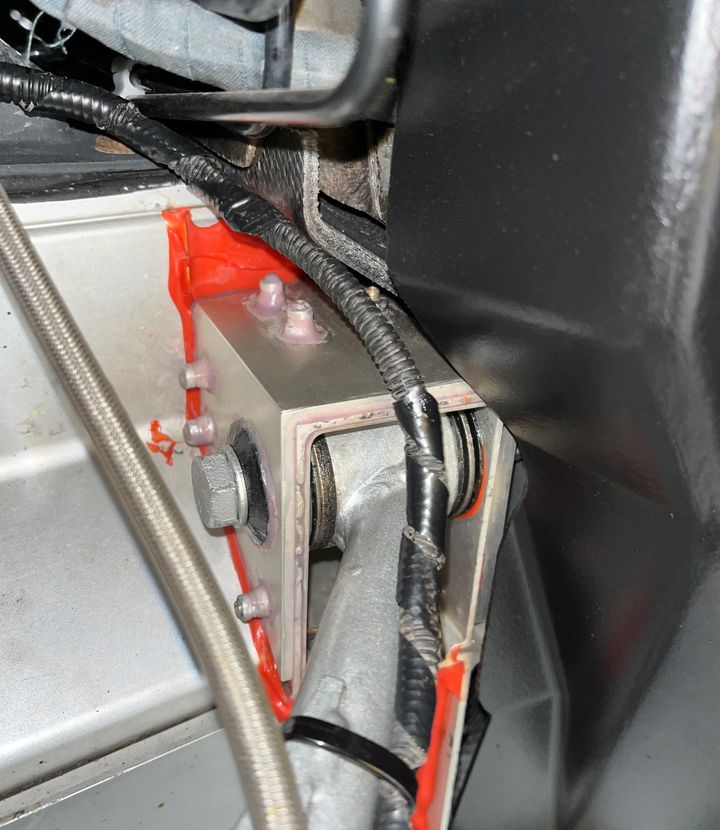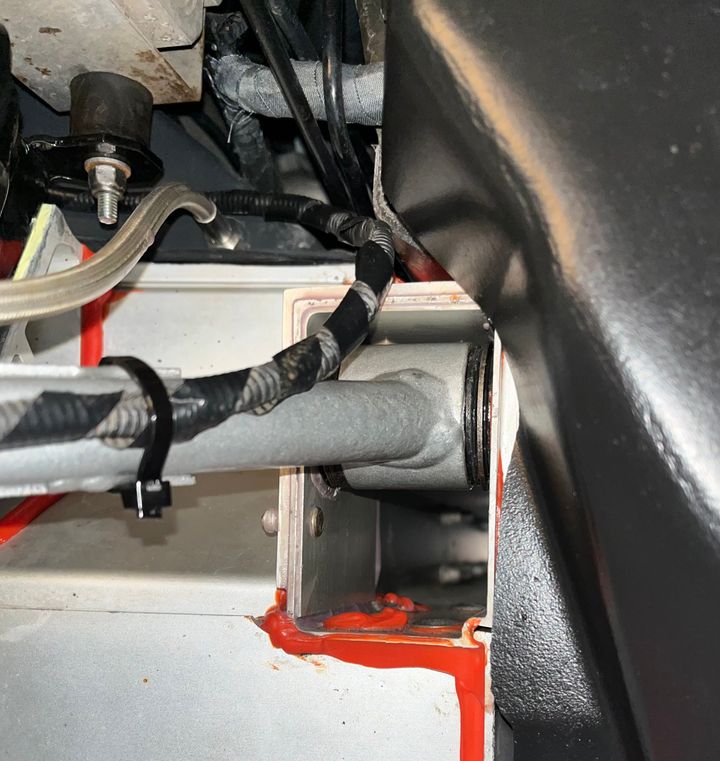Warning to all elise/exige/europa owners/potential owners
Discussion
Perhaps using the inner space of the extrusion is best as you can get greater and clean contact length and use glue not welding. Buy or make a new box section and insert as far as possible (a good length though matron).
Thereafter somehow customising the wishbone end to be more compact and fit in the new box section - keeping the metal parts the same diameter and hacking down the bushes perhaps.
I dont know the parts that well to properly comment though haha!
good luck.
Thereafter somehow customising the wishbone end to be more compact and fit in the new box section - keeping the metal parts the same diameter and hacking down the bushes perhaps.
I dont know the parts that well to properly comment though haha!
good luck.
bencollins said:
Perhaps using the inner space of the extrusion is best as you can get greater and clean contact length and use glue not welding. Buy or make a new box section and insert as far as possible (a good length though matron).
Thereafter somehow customising the wishbone end to be more compact and fit in the new box section - keeping the metal parts the same diameter and hacking down the bushes perhaps.
I dont know the parts that well to properly comment though haha!
good luck.
that's along the lines I was thinking...Thereafter somehow customising the wishbone end to be more compact and fit in the new box section - keeping the metal parts the same diameter and hacking down the bushes perhaps.
I dont know the parts that well to properly comment though haha!
good luck.
remember, the front hard-point is still in place and looks OK, so you only need to re-create the rear one, and it's location is not super-critical as castor is set from the front hardpoint, so you have some room to play with.
Goody.
I wonder if this "slip it a long length matron" repair could be used on so called "unrepairable chassis" with only moderately bent wishbone contact points, pretty typical on most doinks.
Suppose it depends on which hardpoint is bent etc.
It seems a shame some of the cars that get called "write offs", what a waste of a lovely lotus!
Opens worm can.
I wonder if this "slip it a long length matron" repair could be used on so called "unrepairable chassis" with only moderately bent wishbone contact points, pretty typical on most doinks.
Suppose it depends on which hardpoint is bent etc.
It seems a shame some of the cars that get called "write offs", what a waste of a lovely lotus!
Opens worm can.

bencollins said:
Goody.
I wonder if this "slip it a long length matron" repair could be used on so called "unrepairable chassis" with only moderately bent wishbone contact points, pretty typical on most doinks.
Suppose it depends on which hardpoint is bent etc.
It seems a shame some of the cars that get called "write offs", what a waste of a lovely lotus!
Opens worm can.
Manufacturers of aluminium yatch masts have been successfully sleeving broken sections for years - the thought occoured to me when I was looking along the (fortunately good) main chassis rails on my car when doing the suspension earlier this year (had a good look at everything whilst I was under the thing!). I wondered what the chances of successfully sleeving them would be in the event of one getting dinged. Hope I never have to find out though!I wonder if this "slip it a long length matron" repair could be used on so called "unrepairable chassis" with only moderately bent wishbone contact points, pretty typical on most doinks.
Suppose it depends on which hardpoint is bent etc.
It seems a shame some of the cars that get called "write offs", what a waste of a lovely lotus!
Opens worm can.

Out of interest (and sorry if slightly O/T) why not weld the chassis? Is it the difficulty of re-anodising? Or just the proximity to glued joints?
Structural welds in aluminium are well-practiced and I thought TIG generated relatively little heat.
Each time a racing Elise gets clonked does it get a whole new chassis?
Structural welds in aluminium are well-practiced and I thought TIG generated relatively little heat.
Each time a racing Elise gets clonked does it get a whole new chassis?
bencollins said:
If a few more were getting repaired instead of binned then those insurance premiums might tumble.
Quite. My last Exige took a front wheel into an open drain / hidden tree stump at 35 mph and *still* got totally written off (this was a £27k car) so quite what the insurance companies / assessment 'engineers' / salvage firms are doing is bewildering to me.Given there was no clam damage (well none that wouldn't polish out, the nearside wing mirror and front splitter needed replacement, there were a few scratches), that 35 mph impact on the *wheels* must have done more than £14k worth of damage?
Seems crazy to me. I'm OK as I've got a lovely new car... but it cost me £1800 to insure this time round. If the 'specialist engineers' are claiming that *all* minor knocks are unrepairable on Lotuses in order to sell the salvage to Europe at inflated rates (the most likely scam I can think of) then this would explain it, otherwise the insurance companies are *far* too quick to write cars off.
Does the real time cost of repairing a car make it cheaper for a big company to simply throw the old car away and write a cheque for £26,000 if they can wrap up the job in a couple of weeks, as opposed to months getting the thing repaired to the customer's satisfaction?
Seems crazy to me, but quite clearly the cause of inflated insurance premiums.
griffter said:
Out of interest (and sorry if slightly O/T) why not weld the chassis? Is it the difficulty of re-anodising? Or just the proximity to glued joints?
Structural welds in aluminium are well-practiced and I thought TIG generated relatively little heat.
Each time a racing Elise gets clonked does it get a whole new chassis?
your problem with welding is heat, if your far enough away from a bonded joint then you may well be OK, but ali is a good heat conductor, so any significant welding is going to be a problem I would suggest..Structural welds in aluminium are well-practiced and I thought TIG generated relatively little heat.
Each time a racing Elise gets clonked does it get a whole new chassis?
As for the anodising, you cannot re-anodise the chassis, even if you pulled it back to a bare tub.
Racing an Elise is always a risk, but in the 10+ years I have run mine, I have only had to re-chassis it once, it's all about where you hit the car, the only real vulnerable points are the front wheels because of the top wishbone mounts, you can smack the back as hard as you like (within reason) or hit something head-on, just don't hit the front wheels.
Just to add welding aluminium alloy is ok if it is a weldable alloy, but if it is an alloy designed to be glued then it will really spoil it. Welding melts the metal and all the metals resolidify at different temperatures and separate out, leaving pure aluminium bits, i.e. no longer an alloy. Then if it is a heat treated alloy, the heat treatment is also ruined. At the most loaded point on the chassis. Welding is a nasty fix in some scenarios, like this one.
I had an elise in about 2003/4, and replaced the dampers. When I did, I needed to change the upper mounting point for the dampers to bolt into. At the time, best practise was to put a jointing compound (I think I used duralac) in between the stainless upright and the chassis.
Can't imagine the recommendation would be much different today.
Can't imagine the recommendation would be much different today.
At the risk of criticism, but in the hope that it might be useful…..
Coming from the aircraft industry you see this kind of thing a lot; a breakdown of the surface protection of two dissimilar metals, exposed to an electrolyte (particularly salt water), leading to electrolytic corrosion on the exposed aluminium part. Provided it’s not too far gone all you can do is grind out the corrosion down to good metal, re-protect and then strengthen the damaged area.
If you are daily driving your Elise through the winter this is going to be of concern.
So I know I've seen negative comments about repairing this area, but here's what I did; removed the steel bushes, made an internal and external repair angle with the same spec aluminium, anodised them, sandwiched them together with aircraft spec structural adhesive, pinned it with aircraft fasteners, and bonded in new longer steel bushes.
A fairly standard aluminium aircraft hybrid joint repair (riv-bonding) transferred to an Elise!


My advice for prevention, ensure these areas are always kept clean and do not allow any debris to build up around the steel bushes. Don’t damage the protective coatings of the joint area between/around the bush and aluminium chassis when cleaning, and a preventative squirt with ACF50 after cleaning will definitely help. The outside will look ok, it's the inside face of the box section that will go first.
Coming from the aircraft industry you see this kind of thing a lot; a breakdown of the surface protection of two dissimilar metals, exposed to an electrolyte (particularly salt water), leading to electrolytic corrosion on the exposed aluminium part. Provided it’s not too far gone all you can do is grind out the corrosion down to good metal, re-protect and then strengthen the damaged area.
If you are daily driving your Elise through the winter this is going to be of concern.
So I know I've seen negative comments about repairing this area, but here's what I did; removed the steel bushes, made an internal and external repair angle with the same spec aluminium, anodised them, sandwiched them together with aircraft spec structural adhesive, pinned it with aircraft fasteners, and bonded in new longer steel bushes.
A fairly standard aluminium aircraft hybrid joint repair (riv-bonding) transferred to an Elise!
My advice for prevention, ensure these areas are always kept clean and do not allow any debris to build up around the steel bushes. Don’t damage the protective coatings of the joint area between/around the bush and aluminium chassis when cleaning, and a preventative squirt with ACF50 after cleaning will definitely help. The outside will look ok, it's the inside face of the box section that will go first.
Edited by SimpleAndLight on Monday 11th November 17:35
Edited by SimpleAndLight on Monday 11th November 17:36
Gassing Station | Elise/Exige/Europa/340R | Top of Page | What's New | My Stuff




